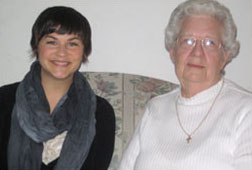
MUSEUM STUDIES
Building Confidence through Experience

No matter how important and relevant they seem, the ideas and theories taught in the classroom never perfectly align with issues and real practices in the working world. Putting theory into practice proves difficult at all levels and in all fields, but especially for beginners not usually given the opportunity to train and rehearse doing so before entering the workforce.
In 2008-9, UNCG Museum Studies students in HIS/IAR 626-627 completed Threads in Greensboro’s Past: The Cone Mill Villages, a project that offered many opportunities for us to learn and practice. We set out to explore the lives of the textile workers who lived in the company towns that the industry had owned from around 1900 through the 1950s. The project began with a sense of urgency because, though many of the houses still stand and the villages remain thriving neighborhoods, the last generation that lived in the villages while they were still company-owned has begun to age.
We started the project with what we called a “Memory Map.” We went all around town—the American Legion Hall, the public libraries, community centers—with a seven-foot-by-seven-foot map of the mill village area and invited current and former mill village residents to write their memories on the map where they happened to them in the neighborhood. We also conducted close to two-dozen interviews during the first half of a semester, engaging the community in a way that helped us familiarize ourselves and them with the project. Then, with the information gathered from the Memory Map and interviews, we created several products including audio and some video recordings of the interviews, which are now archived for future use at several key locations on UNCG’s campus and in town. The project culminated in a public, day-long event where we narrated tours of the villages. Over the course of several hours we took community members out in fifteen-passenger vans every fifteen minutes and shared mill village stories with them! Finally, we designed and printed a self-guided version of the tour including a map with stories about key locations.
Real, practical experiences like we have had through the mill village project helps students feel more confident in their overall education and more willing to apply their theoretical ideologies into practice later. Though this project was just about as real as it gets, and I would like to think it went off without a hitch, we were probably afforded a few mishaps for which we might not be so readily forgiven if we were not still students. This is the kind of nurturing but practical experience that a program directed toward public work should offer. The experiences collected through service-learning projects like Cone Mills are necessary for students’ development into public work professionals.
The concept of shared authority sticks out in my mind as the most prevailing theoretical ideology in relation to the Cone Mills project. If we accomplished anything, it was that. During the tours, not only did we relay stories gathered from those we had interviewed but new stories continued to circulate throughout the tour event. While our collective class voice kept the narrative from becoming disjointed, our conscious use of memories and their expected nuances allowed us to incorporate as many mill village perspectives as possible into the tour narrative. With our own words we shared current and former mill village residents’ voices, which set this project’s unique tone. Finally, our ability to foster positive relationships with the mill village community residents encouraged them and others to come to the event to continue those relationships and conversations while also sparking new ones.
One difficulty I faced in applying the theory of shared authority during the Cone Mill villages tour day was my inability to express some of the tough or not-so-cheerful topics with a tone that properly represented my own perspective. Looking back, I think that I allowed the audience members with first-hand memories, however unintentionally, to intimidate me. In hindsight, I think I treated the engagement more like a social event than a deliberate public historical forum. The experience, however, helped me to realize that I have this habit and that I would like to work on it more before I offer my services to the public in a more professional setting.
After the tours, I spoke with Christie Chapman, an historic preservation designer at Revolution Mill Studios (our host venue) and a 2006 graduate from UNCG’s Interior Architecture/Historic Preservation program. Christie told me that the event had helped remind her exactly why she does historic preservation in the first place. After working in the field for a while, dealing with employer constraints and government regulations, she had let the human factor slip from her priorities. Christie said the mill village project brought back for her that history’s relevance has everything to do with the people who make it, which renewed her work’s sense of purpose.
In all, for a first time around, I feel like we did a pretty bang-up job. Of course we all have lessons to learn from this experience, but I hope that is true with each new project no matter how many years into our professional careers they fall. There is always room for improvement, but simply having the opportunity as students to conceptualize, create, and implement such a rewarding project will allow us to begin our professional careers with a sense of confidence that we would not have otherwise.